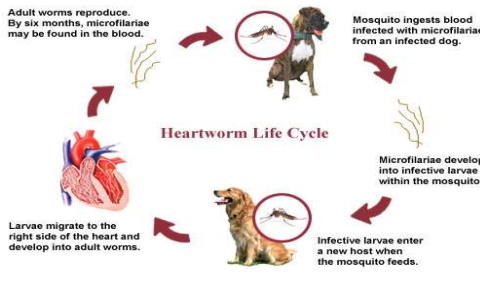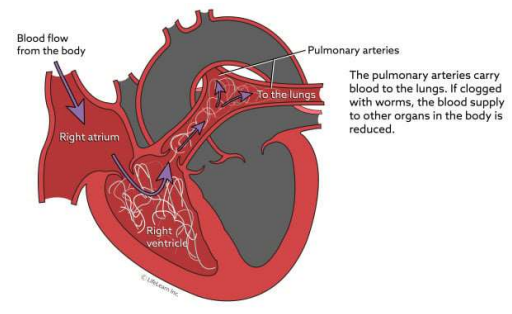The Silent Killer
Heartworm is one of the lesser-known, yet more deadly parasites that can infect our pets, coined ‘the silent killer’ as clinical signs may not develop for months or even years. This usually occurs when there is a large heartworm burden – and for some animals, once symptoms are present, it can be too risky to treat.
Scientists are still conducting studies to find out more about this deadly parasite and the best ways to keep animals safe from it. So far, the conclusion is that prevention is the best form of heartworm control. From a Veterinary professional point of view, pet owners should exercise caution at all times. Although most heartworm positive cases are from North Queensland, there have been increasing prevalence close to home here in the Moreton Bay region (See Figure 1). Here at Narangba Vet Clinic, we diagnose and treat approximately 1-2 cases every year.

Figure 1. Prevalence of heartworm on the Sunshine Coast (Narangba Vet Clinic Facebook page, 2021)
Life Cycle
In order to keep our pets safe from heartworm, one must first understand its life cycle. Unlike their intestinal worm friends, heartworm is carried and transmitted by mosquitoes.
See Figure 2. for a visual representation. In short, a mosquito drinks the blood from an already infected animal and transfers it to a new host when it feeds again. The larvae migrate to the heart, where they develop into adult worms. The adult worms are what cause sickness, disease and even death.

Figure 2. Life cycle (Mackay Vet Hospital, 2022)
Why is heartworm so dangerous?
Both the larval and the adult worm can wreak havoc to the animal’s body (See Figure 3).
Larval microfilaria – because of their size, microfilaria can block the smaller blood vessels of the body relating to lungs, kidney and liver.
Adult worms – once the larvae mature into adult worms, they migrate to the heart. If a big enough worm burden, the major blood vessels and pulmonary arteries can then become clogged, leading to reduced blood and oxygen supply to all major organs of the body. Adult worms are more of a threat to the health of the animal due to the fact that once the worms mature, it is usually indicative of a large burden.

Figure 3. Heartworm infestation (Barnette, C. 2022)
Heartworm infestation symptoms/diagnosis
It usually takes several years before an animal will show any clinical signs of infestation. And once clinical signs are present, the disease is usually well advanced.
This is why most positive cases arise on happen stance. If you have not started/lapsed on heartworm prevention for your pet, Veterinarians will need to perform a heartworm test as basic protocol before commencing heartworm prevention. Regardless of the prevalence of heartworm in the area, it is too great of a risk to give an animal heartworm prevention if they have a heartworm infestation. The heartworm injection/tablet will kill off the adult heartworm – in turn leaving dead heartworm sitting within the arteries of the heart, causing further problems.
If not picked up via a routine heartworm test, the most obvious clinical symptoms of heartworm
infestation can include:
• soft, dry cough
• shortness of breath
• loss of stamina/weakness
• jaundice
• anaemia
• abnormal heart/lung sounds
• fluid build-up in the abdomen and legs
• weight loss/poor condition
• in extreme cases, sudden death
Figure 4: Positive heartworm test (Zoetis, 2022)
What can I expect if my pet undergoes heartworm treatment?
Heartworm treatment is majorly different to heartworm prevention. Once a positive result is obtained from the in-house test, another blood sample needs to be collected and sent to the IDEXX pathology labs to get an official positive result.
Because of the risk of causing further complications, treatment needs to be slow and strict. The projected time-frame for any heartworm treatment plan can last between 12-14 months, with follow up tests done after it is completed.
Here at Narangba Veterinary Clinic, we follow the treatment protocol as outlined by the American Heartworm Society for dogs. More information can be found here: https://www.heartwormsociety.org/.
Once successfully eradicating heartworm from the pets’ system, a maintenance heartworm prevention (as outlined below) can then be given.
Prevention
Current scientific studies have determined that prevention is the best form of heartworm control. As long as your pet is up to date on heartworm prevention, the risk of them contracting the deadly parasite significantly decreases.
Tablet – for dogs, products such as Milbemax and NexGard Spectra are a monthly tablet that has heartworm coverage as part of their prophylaxis. Tablet form of prevention can be given to animals from 6-8 weeks old. In relation to cats, products like Bravecto Plus, Revolution Plus and Milbemax are also readily available.
Yearly injection – for dogs, the Proheart SR12 product is given as an injection for heartworm prevention. For puppies, it starts off as 1x injection at 3 months old, with a 1x injection booster at 6 months old, then yearly thereafter. Cats unfortunately cannot receive this yearly injection, and must be kept up to date with an appropriate tablet that has heartworm prevention as described above.
Heartworm prevention, along with flea, tick and intestinal worm prevention, are the foundations to keeping your pets happy, healthy and disease free.
Call the clinic today if you have any further queries regarding this topic!
Resources
https://www.localvet.com.au/Mackay/heartworm.aspx
https://www.greencrossvets.com.au/pet-library/articles-of-interest/more-information-about-heartwormheartworm-signs-treatment-prevention-greencross-vets/
https://vcahospitals.com/know-your-pet/heartworm-disease-in-dogs
https://www.heartwormsociety.org/images/pdf/2018-AHS-Canine-Guidelines.pdf
https://www2.zoetisus.com/content/_assets/docs/Diagnostics/brochures/WITNESS-Heartworm-Antigen-Test-Kit-eDetailer-WIT-00133.pdf
https://www.petmd.com/cat/parasites/worms-cats-everything-you-need-know
